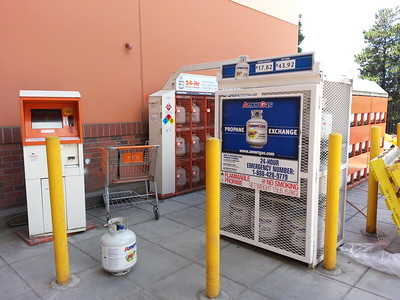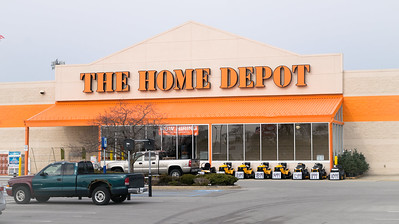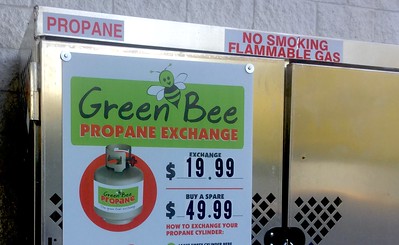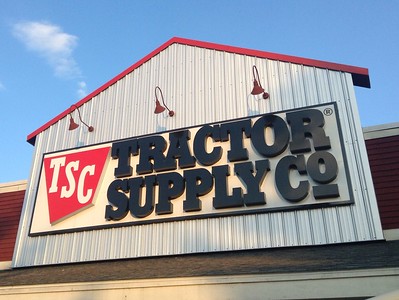
Not all propane tanks are eligible for exchange. The eligibility largely depends on the tank’s condition, as tanks with any damage, such as rust or dents, are usually not accepted.
Additionally, the age of the tank is crucial, with most programs requiring the tank to be within 10-12 years of its manufacture date. The tank must also have an Overfill Protection Device (OPD) valve, which is a standard in newer models.
Finally, the tank’s certification plays a role, as tanks lacking proper certification are typically ineligible for exchange programs.
Here are what to take note of:
Tank Size and Capacity
One of the primary factors influencing a propane tank’s eligibility is its size and capacity. Most locations cater to the standard 20-pound propane tanks, which are commonly used for outdoor grills and patio heaters. Some locations may also accept larger tanks, such as 30 or 40-pound tanks, but this varies from one place to another. It’s essential to check with your local location to see what sizes they accept before attempting to do this.
Tank Brand and Manufacturer
Some locations only accept tanks from specific brands or manufacturers. This is due to the varying standards and quality of propane tanks across the industry. If you have a propane tank from a lesser-known or non-reputable brand, you may have difficulty finding an exchange location that accepts it. Be sure to research and purchase propane tanks from well-known and reputable brands to ensure that you can easily find a location.
Tank Age and Expiration Date
Propane tanks have a limited lifespan, and their eligibility is often affected by their age. Most tanks are stamped with a manufacturing date, which indicates when the tank was produced. Propane tanks typically have a lifespan of 12 years, after which they must be requalified or disposed of. Locations generally do not accept tanks that have expired or are close to their expiration date.
Tank Condition
The physical condition of your propane tank is another important factor that determines its eligibility. Tanks that are rusted, dented, damaged, or have compromised structural integrity may not be accepted. Additionally, tanks with faded or missing labels, illegible markings, or damaged valves may also be ineligible for exchange.
Inspect it for any signs of damage or wear. If you are unsure about the condition of your tank, consult a professional or contact the tank manufacturer for guidance.
Tank Regulations and Safety Standards
Propane tanks must adhere to specific safety standards and regulations set by governing bodies such as the U.S. Department of Transportation (DOT) and the National Fire Protection Association (NFPA). These organizations ensure that propane tanks meet safety requirements for transportation and use.
Some locations are required to follow these regulations, and they may refuse to accept a tank that does not meet the necessary safety standards. Ensure that your tank complies with all applicable regulations before attempting an exchange.
If Not Eligible for Exchange, What Can You Do Then
If your propane tank is not eligible for exchange, you still have a few options to consider:
- Refill the Tank: If your tank is in good condition but simply not eligible due to factors like brand or size, you can choose to refill it at a propane refill station. Refilling a tank is often more cost-effective than exchanging it, and many propane retailers offer this service.
- Requalify the Tank: If your tank has reached its expiration date but is still in good condition, you may be able to have it requalified by a certified propane professional. Requalification involves a thorough inspection and, if necessary, replacement of some components to ensure the tank meets safety standards. After requalification, the tank will receive a new expiration date and can be used for an extended period.
- Purchase a New Tank: If your tank is damaged, expired, or does not meet the required safety standards, it may be best to dispose of it and purchase a new one. A new tank from a reputable brand will ensure that you have a safe and compliant container for propane storage and can participate in future exchanges without issue.
- Recycle or Dispose of the Tank: If your tank is no longer safe for use, you should properly recycle or dispose of it. Some local recycling centers or hazardous waste facilities accept propane tanks. Before taking your tank to a recycling or disposal facility, ensure that it is completely empty and the valve is removed or open. Contact your local waste management or recycling center for specific instructions on propane tank disposal in your area.
Some other things to remember:
- What to Do with Tanks You Can’t Exchange
- If a place won’t take your tank for an exchange, you still have options. You can’t just throw it away like regular trash.
- How to Get Rid of Old or Broken Tanks Safely
- For tanks that are too old or damaged, you need to dispose of them safely. It’s important not to just leave them anywhere because they could be dangerous.
- There are special places that take these tanks and get rid of them the right way. You can often find these places by doing a quick online search or asking at a local hardware store.
- Refilling Your Tank Instead of Exchanging It
- Another option is to refill your tank instead of exchanging it. This means taking your tank to a place where they fill it up with propane for you.
- Pros of Refilling: It can be cheaper, and you keep your own tank.
- Cons of Refilling: Not all tanks can be refilled, especially if they’re old or not in good shape. Plus, you have to find a refill station, which might not be as convenient as exchanging.
Remember that it is essential to handle propane tanks with care and follow proper safety guidelines at all times. If you are unsure about the best course of action for your tank, consult a propane professional or your tank’s manufacturer for guidance.
What Makes a Propane Tank Eligible for Exchange?
- Rules for Tank Eligibility: Age and Condition
- Age: There’s a limit on how old your tank can be for an exchange. Usually, tanks older than a certain number of years (often around 10-12 years) might not be accepted.
- Condition: Your tank needs to be in good shape. This means no rust, dents, or serious damage. The tank should look safe to use and not be leaking.
- Different Rules from Different Exchange Services
- Each place that exchanges tanks, like hardware stores or gas stations, might have their own set of rules. Some might be stricter than others. For example, one place might accept older tanks, while another might not.
- It’s a good idea to check these rules before you go. You can usually find them on the service’s website or by giving them a quick call.
- Why Safety Standards are Key
- Safety is the biggest reason for these rules. A damaged or old tank can be dangerous – it could leak propane or even cause an accident.
- Following safety standards means everyone stays safe – you, the people exchanging the tank, and anyone around when you use your propane.
- These standards are there to make sure that every tank exchanged is safe to fill up and use again.
In short, when you want to exchange your propane tank, make sure it’s not too old, it’s in good physical shape, and you know the specific rules of the place where you’re exchanging it.
Different Sizes of Propane Tank Available
Propane tank exchange programs typically focus on the most common propane tank sizes. However, the availability of specific sizes and their corresponding prices may vary depending on the location, retailer, or supplier. Below is a general overview of the most common propane tank sizes available and their approximate prices:
- 20-pound (5-gallon) tanks: These are the most common propane tank sizes used for residential purposes, such as grilling and patio heaters. The price for a 20-pound tank typically ranges between $18 and $25.
- 30-pound (7-gallon) tanks: Slightly larger than the standard 20-pound tank, these tanks are often used for RVs, campers, and some patio heaters. The price for a 30-pound tank typically falls between $25 and $35, although not all locations offer this size.
- 40-pound (10-gallon) tanks: These tanks are used in a variety of applications, including forklifts, RVs, and residential heating. The price for a 40-pound tank can range between $45 and $60, but their availability for exchange is less common compared to 20-pound tanks.
- 100-pound (25-gallon) tanks: Typically used for commercial and residential heating, these tanks are much larger and generally not available for exchange at most locations. They are usually refilled instead.
Please note that the prices mentioned above are approximate and can vary based on factors such as location, seasonal demand, and the specific retailer or supplier. To get the most accurate and up-to-date pricing information, it’s best to contact your local provider or check their website.
In addition to the sizes listed above, there are other propane tank sizes on the market used for various purposes. However, these tanks are typically not eligible for exchange and must be refilled or replaced when empty.
- Different Kinds of Propane Tanks
- Propane tanks come in various sizes and shapes. Some are big, some are small.
- They also have different brands. Just like how cars have different makers, propane tanks have different companies that make them.
- Which Tanks Usually Get Accepted or Not
- Most exchange places take common types of tanks. If your tank looks like the ones usually used for grills, it’s likely accepted.
- Some tanks might not be accepted. This can be because of their size, shape, or brand. It’s like how some recycling centers only take certain types of bottles.
- Special Rules for Unique or Old Tanks
- If your tank is really old or unusual, there might be special rules. It’s like having a vintage car – not every mechanic will work on it.
- These tanks might need a special place for exchange, or they might not be accepted at all.
Importance of Understanding Exchange Eligibility
Understanding the eligibility is crucial for several reasons. By being aware of the factors that determine whether a tank can be exchanged, you can avoid inconvenience, save time and money, and ensure safety. Below are the key reasons why understanding propane tank exchange eligibility is important:
- Avoiding Inconvenience: Knowing whether your propane tank is eligible for exchange beforehand can save you the trouble of going to a location only to discover that they do not accept your tank. This can save you time and the hassle of finding an alternative solution.
- Saving Money: By purchasing a propane tank from a reputable brand and ensuring it meets the necessary criteria, you increase the likelihood that your tank will be accepted at locations. This can save you money in the long run, as exchanging tanks is often more cost-effective than refilling them or purchasing a new tank altogether.
- Ensuring Safety: Propane tanks must meet specific safety standards and regulations to be eligible for exchange. By understanding these requirements and ensuring your tank complies, you can be confident that your tank is safe for use. Using a tank that is damaged, expired, or does not meet safety standards can pose a serious risk to you and others around you.
- Proper Disposal and Environmental Responsibility: If a propane tank is ineligible due to its age or condition, it is essential to dispose of it properly. Understanding the reasons why a tank is ineligible can guide you in taking appropriate steps for disposal, thus preventing potential hazards and promoting environmental responsibility.
- Planning Ahead: By being aware of the factors that determine eligibility, you can plan your propane needs more effectively. For instance, knowing that your tank will soon reach its expiration date can prompt you to start looking for a replacement or requalification options before you run out of propane.
Understanding eligibility is essential to avoid inconvenience, save money, ensure safety, promote environmental responsibility, and plan your propane needs effectively. By staying informed about the factors that determine eligibility, you can make better choices when purchasing and maintaining your propane tanks.
Conclusion
To wrap up, whether you can exchange your propane tank depends on a few things. It’s important to know that not all tanks are accepted. The tank needs to be in good shape, not too old, and match the rules of the exchange place.
Remember, these rules are there for safety. If your tank isn’t right for exchange, look into other options like safely getting rid of it or refilling it. Always put safety first when dealing with propane tanks.
In the end, understanding the ins and outs of propane tank exchange can save you time and hassle. If you find your tank doesn’t meet the requirements for an exchange, don’t worry. There are always other paths to take, like finding a place to safely dispose of it or seeing if it’s eligible for a refill.
Remember, handling propane tanks requires care, so whatever option you choose, make sure it’s done safely and responsibly. This way, you can enjoy the benefits of your propane tank without any worries.

Mike is an experienced propane technician with over 15 years of professional experience in the field. He has dedicated his career to helping customers with their propane needs, from installation to maintenance and repair. Together with Jeremy, he co-founded this website to provide useful information and guidance to customers seeking reliable propane services.



